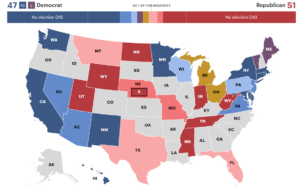 Welcome to October and this Presidential campaign’s latest lull of uncertainty. At this moment, we’re less than two weeks out and all seven swing states look to be within the margin of error.
Welcome to October and this Presidential campaign’s latest lull of uncertainty. At this moment, we’re less than two weeks out and all seven swing states look to be within the margin of error.
It’s at times like these when people who spend far too much of their lives thinking about politics – let’s face it, people like myself – ponder the various paradoxes in the polling. Right now, nothing confounds political junkies more than the ticket-splitting mystery.
After all, we’ve spent decades now watching the conspicuous decline of split-ticket voting, a drop that’s been especially prominent between Presidential and Senate contests. In 2016, for the first time in history, there were no states that split their Presidential and Senate results. Then, in 2020, Susan Collins of Maine was the sole Senate candidate to pull off a split-ticket victory.
Given all that, how can we explain the following polling averages; which suggest we could see up to five Republican President/Democratic Senate split-ticket results in November?
Arizona President: Trump+1.7%
Arizona Senate: Gallego+7.3%
Michigan President: Trump+0.9%
Michigan Senate: Slotkin+3.2%
Nevada President: Trump+0.3%
Nevada Senate: Rosen+6.2%
Pennsylvania President: Trump +0.2%
Pennsylvania Senate: Casey+3.3%
Wisconsin President: Trump+0.2%
Wisconsin Senate: Baldwin+1.8%
Now, this Presidential-Senate gap has existed in these states for months, but it was theorized back then that it could be the result of voters not knowing enough about the GOP Senate candidates yet, or of President Biden’s unique unpopularity.
Of course, now it’s late-October and Joe Biden is no longer the Democratic nominee. Moreover, Harris is recording much higher favorability numbers than Biden, and she’s doing better in the national polls as well.
Which brings us to another possibility, that these Senate surveys are a red flag indicating that polls are over-rating Donald Trump’s support. Under this theory, in an attempt to prevent the polling errors of 2016 and 2020, pollsters are weighing results too much in Trump’s favor, perhaps over-stating his support among nonwhite voters.
Now the dangers inherent in this idea are obvious: Who wants to look like the fool who under-rated Trump’s chances for the third time in a row?
Yet Trump’s 2024 strategy depends on turning out low-propensity voters, those who don’t usually show up. Is it reasonable to expect him to match his turnout from four years ago, when a worldwide pandemic led to the highest voter participation rate in 120 years? Furthermore, if all these new voters were primed to show up for Trump, wouldn’t we see signs of it in his fundraising and crowd sizes?
This all really gets to the heart of the conundrum of analyzing any Donald Trump candidacy: He’s never won a plurality of the popular vote, or even held a plurality positive approval rating. Nevertheless he’s also survived impeachments, liability lawsuits, criminal convictions and assassination attempts, all the while staying on top in Presidential politics for longer than any American politician since Richard Nixon.
After nine years of watching Donald Trump, I still don’t know that any of us can definitively say whether he is a uniquely poor candidate or a uniquely strong candidate.
On top of all this, there is a geographical component that we must touch on as well. Recently, the GOP Senate nominees in Michigan, Pennsylvania and Wisconsin have closed the gap, although they’re all still trailing. This would suggest that low-information Republicans may well be starting to embrace down-ballot candidates.
On the other hand, as you already saw above, Democratic Senate candidates remain far ahead in Arizona and Nevada. Those results present a baffling meme-worthy contradiction. After all, why would a subset of voters who support Donald Trump while refusing to support GOP Senate nominee Kari Lake?
Furthermore, the Nevada numbers suggest this isn’t just a Kari Lake issue. Although, since it involves two Western states, perhaps we’re seeing that the Latino men interested in Trump simply aren’t willing to vote for the Republican Senate candidates. That explanation, however, doesn’t pass muster either.
Let’s imagine a young Hispanic man living in Las Vegas. He’s the stereotypical Trump convert; he’s a UFC fan and he listens to the Joe Rogan podcast. Wouldn’t this guy also watch College Football on Saturday, the NFL on Sunday, and perhaps some playoff baseball too? Therefore, wouldn’t he see tons of TV ads about Nevada’s Senate race over the last few weeks? So does it make sense that he would favor a conventional female Democratic incumbent like Jacky Rosen over Army veteran Republican Sam Brown? Something just doesn’t fit.
Ultimately, I’m forced to go back to William Goldman’s famous description of Hollywood: “Nobody Knows Anything”. Perhaps Trump underperforms his polls, or maybe the Senate Democrats do so instead; and it’s even possible we do actually see a significant uptick in split-ticket voters.
We simply won’t know until the votes start to be counted on the night of November 5th.